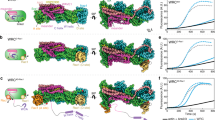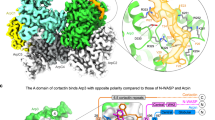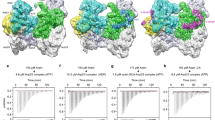Abstract
Members of the Wiskott-Aldrich syndrome protein (WASP) family link Rho GTPase signaling pathways to the cytoskeleton through a multiprotein assembly called Arp2/3 complex. The C-terminal VCA regions (verprolin-homology, central hydrophobic, and acidic regions) of WASP and its relatives stimulate Arp2/3 complex to nucleate actin filament branches. Here we show by differential line broadening in NMR spectra that the C (central) and A (acidic) segments of VCA domains from WASP, N-WASP and Scar bind Arp2/3 complex. The C regions of these proteins have a conserved sequence motif consisting of hydrophobic residues and an arginine residue. Point mutations in this conserved sequence motif suggest that it forms an amphipathic helix that is required in biochemcial assays for activation of Arp2/3 complex. Key residues in this motif are buried through contacts with the GTPase binding domain in the autoinhibited structure of WASP and N-WASP, indicating that sequestration of these residues is an important aspect of autoinhibition.
This is a preview of subscription content, access via your institution
Access options
Subscribe to this journal
Receive 12 print issues and online access
$189.00 per year
only $15.75 per issue
Buy this article
- Purchase on Springer Link
- Instant access to full article PDF
Prices may be subject to local taxes which are calculated during checkout






Similar content being viewed by others
References
Borisy, G.G. & Svitkina, T.M. Actin machinery: pushing the envelope. Curr. Opin. Cell Biol. 12, 104–112 (2000).
Pantaloni, D., Le Clainche, C. & Carlier, M.F. Mechanism of actin-based motility. Science 292, 1502–1506 (2001).
Svitkina, T.M. & Borisy, G.G. Arp2/3 complex and actin depolymerizing factor/cofilin in dendritic organization and treadmilling of actin filament array in lamellipodia. J. Cell Biol. 145, 1009–1026 (1999).
Higgs, H.N. & Pollard, T.D. Regulation of actin filament network formation through Arp2/3 complex: activation by a diverse array of proteins. Annu. Rev. Biochem. 70, 649–676 (2001).
Machesky, L.M. & Gould, K.L. The Arp2/3 complex: a multifunctional actin organizer. Curr. Opin. Cell Biol. 11, 117–121 (1999).
Caron, E. Regulation of Wiskott-Aldrich syndrome protein and related molecules. Curr. Opin. Cell Biol. 14, 82–87 (2002).
Weaver, A.M., Young, M.E., Lee, W.L. & Cooper, J.A. Integration of signals to the Arp2/3 complex. Curr. Opin. Cell Biol. 15, 23–30 (2003).
Frischknecht, F. & Way, M. Surfing pathogens and the lessons learned for actin polymerization. Trends Cell Biol. 11, 30–38 (2001).
Ochs, H.D. The Wiskott-Aldrich syndrome. Clin. Rev. Allergy Immunol. 20, 61–86 (2001).
Devriendt, K. et al. Constitutively activating mutation in WASP causes X-linked severe congenital neutropenia. Nat. Genet. 27, 313–317 (2001).
Higgs, H.N., Blanchoin, L. & Pollard, T.D. Influence of the C terminus of Wiskott-Aldrich syndrome protein (WASp) and the Arp2/3 complex on actin polymerization. Biochemistry 38, 15212–15222 (1999).
Miki, H., Miura, K. & Takenawa, T. N-WASP, a novel actin-depolymerizing protein, regulates the cortical cytoskeletal rearrangement in a PIP2-dependent manner downstream of tyrosine kinases. EMBO J. 15, 5326–5335 (1996).
Marchand, J.B., Kaiser, D.A., Pollard, T.D. & Higgs, H.N. Interaction of WASP/Scar proteins with actin and vertebrate Arp2/3 complex. Nat. Cell Biol. 3, 76–82 (2001).
Miki, H. & Takenawa, T. Direct binding of the verprolin-homology domain in N-WASP to actin is essential for cytoskeletal reorganization. Biochem. Biophys. Res. Comm. 243, 73–78 (1998).
Yamaguchi, H. et al. Two tandem verprolin homology domains are necessary for a strong activation of Arp2/3 complex-induced actin polymerization and induction of microspike formation by N-WASP. Proc. Natl. Acad. Sci. USA 97, 12631–12636 (2000).
Rohatgi, R. et al. The interaction between N-WASP and the Arp2/3 complex links Cdc42-dependent signals to actin assembly. Cell 97, 221–231 (1999).
Sasaki, N., Miki, H. & Takenawa, T. Arp2/3 complex-independent actin regulatory function of WAVE. Biochem. Biophys. Res. Commun. 272, 386–390 (2000).
Machesky, L.M. & Insall, R.H. Scar1 and the related Wiskott-Aldrich syndrome protein, WASP, regulate the actin cytoskeleton through the Arp2/3 complex. Curr. Biol. 8, 1347–1356 (1998).
Eden, S. & Kirschner, M.W. Inhibition of Scar/WAVE proteins by the Pir121/NAP-1 Dimer is relieved by Rac. Nature 418, 790–793 (2002).
Kim, A.S., Kakalis, L.T., Abdul-Manan, N., Liu, G.A. & Rosen, M.K. Autoinhibition and activation mechanisms of the Wiskott-Aldrich syndrome protein. Nature 404, 151–158 (2000).
Rohatgi, R., Ho, H.Y. & Kirschner, M.W. Mechanism of N-WASP activation by CDC42 and phosphatidylinositol 4,5-bisphosphate. J. Cell Biol. 150, 1299–1310 (2000).
Higgs, H.N. & Pollard, T.D. Activation by Cdc42 and PIP(2) of Wiskott-Aldrich syndrome protein (WASp) stimulates actin nucleation by Arp2/3 complex. J. Cell Biol. 150, 1311–1320 (2000).
Buck, M., Xu, W. & Rosen, M.K. Global disruption of the WASP autoinhibited fold on Cdc42 binding. Ligand displacement as a novel method to monitor amide hydrogen exchange. Biochemistry 40, 14115–14122 (2001).
Prehoda, K.E., Scott, J.A., Mullins, R.D. & Lim, W.A. Integration of multiple signals through cooperative regulation of the N- WASP-Arp2/3 complex. Science 290, 801–806 (2000).
Muhandiram, D.R. & Kay, L.E. Gradient-enhanced triple-resonance three-dimensional NMR experiments with improved sensitivity. J. Magn. Reson. B 103, 203–216 (1994).
Panchal, S.C., Bhavesh, N.S. & Hosur, R.V. Improved 3D triple resonance experiments, HNN and HN(C)N, for HN and 15N sequential correlations in (13C, 15N) labeled proteins: application to unfolded proteins. J. Biomol. NMR 20, 135–147 (2001).
Wishart, D.S. & Sykes, B.D. The 13C chemical-shift index: a simple method for the identification of protein secondary structure using 13C chemical-shift data. J. Biomol. NMR 4, 171–180 (1994).
Zalevsky, J., Grigorova, I. & Mullins, R.D. Activation of the Arp2/3 complex by the Listeria acta protein. Acta binds two actin monomers and three subunits of the Arp2/3 complex. J. Biol. Chem. 276, 3468–3475 (2001).
Matsuo, H. et al. Identification by NMR spectroscopy of residues at contact surfaces in large, slowly exchanging macromolecular complexes. J. Am. Chem. Soc. 121, 9903–9904 (1999).
Pistor, S. et al. Mutations of arginine residues within the 146-KKRRK-150 motif of the ActA protein of Listeria monocytogenes abolish intracellular motility by interfering with the recruitment of the Arp2/3 complex. J. Cell Sci. 113, 3277–3287. (2000).
Machesky, L.M. et al. Scar, a WASp-related protein, activates nucleation of actin filaments by the Arp2/3 complex. Proc. Natl. Acad. Sci. USA 96, 3739–3744 (1999).
Pollard, T.D. & Cooper, J.A. Quantitative analysis of the effect of Acanthamoeba profilin on actin filament nucleation and elongation. Biochemistry 23, 6631–6641 (1984).
Notarangelo, L.D. et al. Missense mutations of the WASP gene cause intermittent X-linked thrombocytopenia. Blood 99, 2268–2269. (2002).
Prehoda, K.E., Lee, D.J. & Lim, W.A. Structure of the enabled/VASP homology 1 domain-peptide complex: a key component in the spatial control of actin assembly. Cell 97, 471–480 (1999).
Zalevsky, J., Lempert, L., Kranitz, H. & Mullins, R.D. Different WASP family proteins stimulate different Arp2/3 complex-dependent actin-nucleating activities. Curr. Biol. 11, 1903–1913 (2001).
Robinson, R.C. et al. Crystal structure of arp2/3 complex. Science 294, 1679–1684 (2001).
Volkmann, N. et al. Structure of Arp2/3 complex in its activated state and in actin filament branch junctions. Science 293, 2456–2459 (2001).
Le Clainche, C., Didry, D., Carlier, M.F. & Pantaloni, D. Activation of Arp2/3 complex by Wiskott-Aldrich syndrome protein is linked to enhanced binding of ATP to Arp2. J. Biol. Chem. 276, 46689–46692 (2001).
Dayel, M.J., Holleran, E.A. & Mullins, R.D. Arp2/3 complex requires hydrolyzable ATP for nucleation of new actin filaments. Proc. Natl. Acad. Sci. USA 98, 14871–14876 (2001).
MacLean-Fletcher, S. & Pollard, T.D. Identification of a factor in conventional muscle actin preparations which inhibits actin filament self-association. Biochem. Biophys. Res. Comm. 96, 18–27 (1980).
Yamazaki, T., Lee, W., Arrowsmith, C., Muhandiriam, D. & Kay, L. A suite of triple resonance NMR experiments for the backbone assignment of 15N, 13C, 2H labeled proteins with high sensitivity. J. Am. Chem. Soc. 116, 11655–11666 (1994).
Delaglio, F. et al. NMRPipe: a multidimensional spectral processing system based on UNIX pipes. J. Biomol. NMR 6, 277–293 (1995).
Johnson, B.A. & Blevins, R.A. NMRView: a computer program for the visualization and analysis of NMR data. J. Biomol. NMR 4, 603–614 (1994).
Acknowledgements
We thank S. Padrick for writing Mathematica scripts used in the analysis of anisotropy data. This work was supported by grants from the US National Institutes of Health (NIH) and Welch Foundation to M.K.R. and an NIH research grant to T.D.P.
Author information
Authors and Affiliations
Corresponding author
Ethics declarations
Competing interests
The authors declare no competing financial interests.
Rights and permissions
About this article
Cite this article
Panchal, S., Kaiser, D., Torres, E. et al. A conserved amphipathic helix in WASP/Scar proteins is essential for activation of Arp2/3 complex. Nat Struct Mol Biol 10, 591–598 (2003). https://doi.org/10.1038/nsb952
Received:
Accepted:
Published:
Issue Date:
DOI: https://doi.org/10.1038/nsb952
This article is cited by
-
The effects of 808-nm near-infrared laser light irradiation on actin cytoskeleton reorganization in bone marrow mesenchymal stem cells
Cell and Tissue Research (2021)
-
LASP1 interacts with N-WASP to activate the Arp2/3 complex and facilitate colorectal cancer metastasis by increasing tumour budding and worsening the pattern of invasion
Oncogene (2020)
-
Complimentary action of structured and unstructured domains of epsin supports clathrin-mediated endocytosis at high tension
Communications Biology (2020)
-
WasC, a WASP family protein, is involved in cell adhesion and migration through regulation of F-actin polymerization in Dictyostelium
Journal of Microbiology (2020)
-
BAR domain proteins—a linkage between cellular membranes, signaling pathways, and the actin cytoskeleton
Biophysical Reviews (2018)



